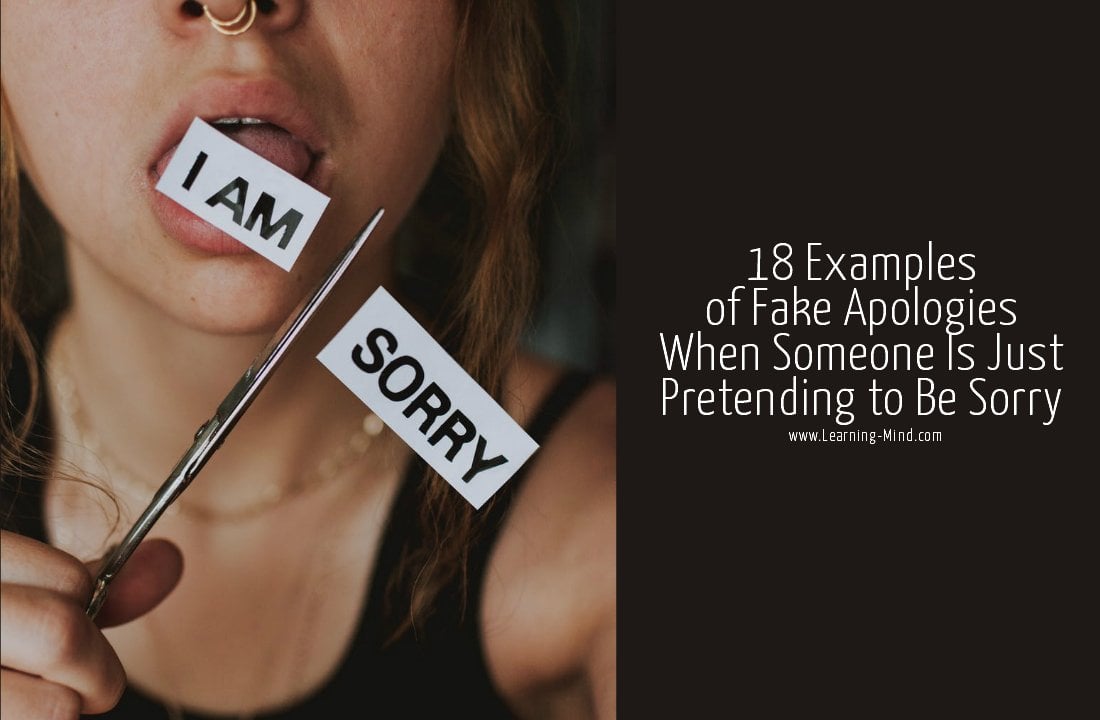18 Backhanded Apology Examples When Someone Is Not Really Sorry

Have you ever had an apology that didn’t feel sincere? Did you think at the time that it was a backhanded apology and you should not have accepted it?
There are many reasons why a person doesn’t want to apologise but feels they have to. They might want to get out of a confrontation, or they don’t think they have anything to say sorry for.
In this article, I want to examine reasons and examples of a fake apology so we can focus on how to respond to one. But first, what does a real apology look like? According to experts, there are four factors when offering an apology:
A genuine apology will contain four factors:
Now that the basics of a genuine apology are clear, what do fake apologies look like?
Types and Examples of Backhanded Apologies
1. Sorry Not Sorry
- “I’m sorry you feel that way.”“I’m sorry if I offended you.”“I’m sorry if you think what I did was wrong.”
This is a classic example of a non-apology apology. The person is saying ‘I’m sorry’, but not for what they did. They are apologising for how you feel about what they did. In other words, they are not taking the blame for their actions.
What to do:
Use their own words against them. Tell them why you feel a certain way. Why you were offended or tell them what they did was wrong. Explain that they are to blame for how you feel and that they need to own it.
2. I’ve Said Sorry!
- “I’m sorry alright!”
- “I’ve said I’m sorry, what more do you want?”
- “I already said sorry.”
Some people think that just saying the words ‘I’m sorry‘ is enough. This kind of backhanded apology shuts down an argument or confrontation. The matter is closed because I’ve said I’m sorry, now let’s move on.
Tell the person that simply saying sorry is not addressing the main issues. Talk over what happened to get proper closure. If they can’t be bothered, then there’s no reason why they have to be in your life.
3. I’ll Apologise If…
- “Look, I’ll apologise if you do.”
- “I’ll say sorry if you stop acting like a drama queen.”
- “I’ll apologise if you don’t bring it up again.”
These are backhanded apology examples of attaching conditions to the apology. There is no genuine remorse or acceptance for wrongdoing. The offender is not dealing with the issue.
The offender is asserting power and control over the situation. You find this kind of technique with manipulators such as psychopaths and sociopaths.
Watch out for this type of fake apology because it is often a manipulation sign. This might be your first incident where you feel something isn’t quite right. Tell the person that a genuine apology doesn’t come with ready-made conditions.
4. Sorry You Are So Sensitive
- “I was only joking!”
- “I didn’t mean to upset you.”
- “I was only trying to help.”
This is another shifting the blame tactic. The onus is on the other person for being so sensitive that they can’t take a joke or criticism.
This type of fake apology is minimising the apologising person’s actions. In other words, it’s your fault you are so fragile. This is a typical gaslighting technique used by narcissists.
I had an ex that would say cruel things to me and then berate me for being ‘so sensitive’. Put your foot down in cases like these.
No one has the right to be mean or bitchy and then pass it off as a joke or something that doesn’t matter to you. It does matter how people treat you.
5. You Know How Sorry I Am
- “I never meant to hurt you.”
- “You know how awful I feel.”
- “I feel terrible about what’s happened.”
Backhanded apology examples like these ignore all the rules of a genuine apology. A genuine apology acknowledges the other person, it expresses regret and asks for forgiveness.
The above non-apology examples focus on the offending person and their feelings, not the victim.
No, we don’t know how sorry you are because you are not actually apologising.
Ask the person to clarify exactly what they are apologising for and how they plan to change their behaviour in the future. If they have no idea, they are obviously using backhanded apologies.
6. I’m Sorry But…
- “I’m sorry you are upset but you were being unreasonable.”
- “I apologise but you did bring this on yourself.”
- “I’m sorry I yelled at you but I’d had a rough day.”
If any apology includes the word ‘but’, it is a fake apology. When you add ‘but’, nothing that came before the but matters, only what comes afterwards. So don’t accept an apology with a but.
No buts, no ifs. Is the person trying to blame you for your behaviour? If you are the problem, why are they even attempting to apologise? Explain that when they add ‘but’ to an apology, it negates the sentiment.
Final Words
Genuine apologies are heartfelt, remorseful, and factor in a desire to change toxic behaviour. If you recognise any of the above non-apology examples, don’t put up with a fake ‘sorry’.
If you deserve an authentic apology, demand one, not a backhanded version.
Read the full article at the original website
References:
- https://www.learning-mind.com/saying-sorry-too-much/
- https://www.learning-mind.com/dealing-with-guilt/
- https://www.learning-mind.com/blaming-yourself-everything-stop/
- https://www.learning-mind.com/im-sorry-you-feel-that-way/
- https://www.learning-mind.com/blame-game-toxic-people/
- https://www.learning-mind.com/emotional-manipulation-tactics/
- https://www.learning-mind.com/blame-shifting-signs-deal/
- https://www.learning-mind.com/gaslighting-techniques/
- https://www.learning-mind.com/blaming-others-your-failures-truths/
- https://www.huffingtonpost.co.uk/entry/im-sorry-you-feel-that-way-apology_n_5acd47e5e4b06a6aac8cce67
- https://www.psychologytoday.com/gb/blog/the-squeaky-wheel/201311/the-five-ingredients-effective-apology
- https://www.learning-mind.com/author/janey/
- https://www.learning-mind.com/backhanded-apology-examples/
- https://www.learning-mind.com/weird-things-psychopaths-do/
- https://www.learning-mind.com/self-sabotaging-your-relationship/
- https://www.learning-mind.com/contact/
- https://www.amazon.com/dp/B08LTNJVTZ
